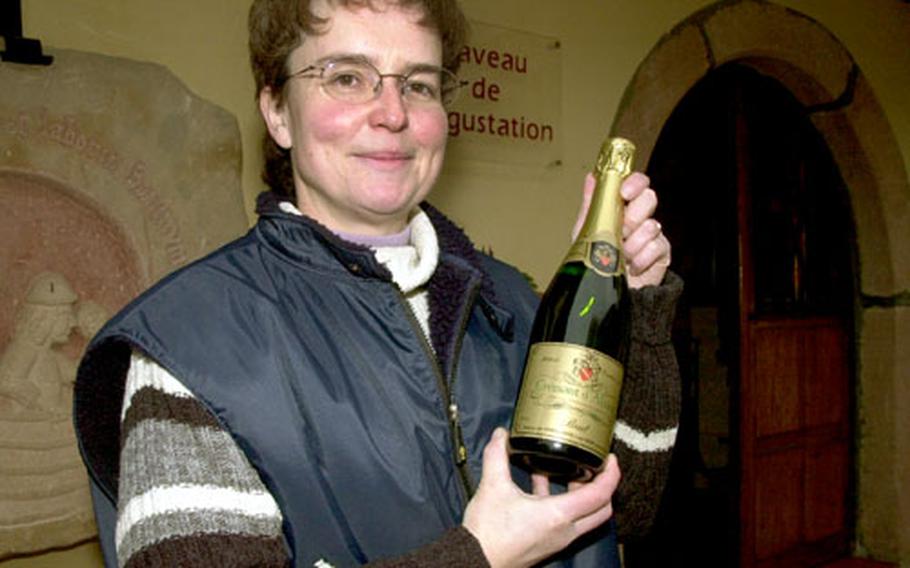
Crémant is the least-know of Alsatian wines, said Natalie Paule Kooborie, whose family owns Koeberle Kreyer. (Photos by Terry Boyd / S&S)
I don’t know about you, but I love getting good wine for Christmas.
I’m talking about the stuff I’m too cheap (and poor) to buy myself: the chateaux-bottled Bordeaux from France or the first-growth Cabernet Sauvignons from California.
What I’ll be giving this year is something else again: Crémant d’Alsace. the best wine bargain I’ve seen in Europe.
Crémant is basically champagne. But because this is a sparkling wine made in Alsace, not the Champagne region of France just east of Paris, it can’t be called Champagne. Yet just like its more glamorous cousin, Crémant is made with the labor-and-cost intensive méthode champenoise, and some of the same grapes.
Where it differs most dramatically from Champagne is in the price. Mid-quality Champagnes such as Mumm and Veuve Clicquot go for $30 a bottle and up. Artisan blends such as Remi Krug’s start at $100 a bottle.
I buy Crémant for 6.75 euros per bottle in a little village just off the French Wine Road called Rodern. Unlike the charming towns around it, Rodern — between St. Hippolyte and the medieval town of Bergheim — has nothing much going for it except wine. But there are a half-dozen small “caves,” or wine vendors, in this little town, an easy drive from U.S. bases in southwest Germany.
One of the painful lessons I’ve learned about wine is that caves don’t necessarily offer the best prices. I’ve paid 7 or 8 euros per bottle at caves, only to see the same wine at the supermarket for 5 euros. Which makes sense: I’m buying a case, the markets buy 5,000. Of course they get a better price.
But it’s difficult to find Crémant outside Alsace. So few bottles are produced — perhaps 50,000 — that they’re all consumed either by locals or sold to the steady stream of tourists to Alsace, said Natalie Paule Kooborie, whose family owns Koeberle Kreyer, a 343-year-old Rodern vintner.
The Alsatians love to drink it with local recipes including fish in sauce, Kooborie said. But Paul Klein, a local vintner, said Crémant is still a special-occasion treat, which limits sales.
“At our house, we call it the birthday wine,” said the 69-year- old farmer as he laboriously pruned Tokay grapes just south of Rodern. Ordinary Alsatians think nothing of having what outsiders would consider extraordinary wines for a meal, Klein said, while saving the comparatively cheap Crémant.
Crémant is the ugly stepsister of Alsatians wines, Kooborie said. The area is renowned for its expensive grand cru (first growth) Rieslings and stunning Pinot Blancs and even Gewurtztraminer. And really, Crémant is German wine, not French, since Alsace, claimed both by Germany and France since 1878, is in the narrow lowlands between the French Vosges mountain range and Germany’s Black Forest – about 200 miles southeast of Reims, the center of the Champagne biz.
Crémant differs from Champagnes in that it’s typically a blend of Pinot Noir, Tokay and Chardonnay grapes, whereas the best Champagne is made completely from Chardonnay or Pinot Noir grapes. What makes Crémant inexpensive is two things, Kooborie said.
First, a kilo of grapes costs a lot less in Alsace than in the Champagne region, she said. Second, Crémant, unlike the Tokays, Rieslings and other Alsatian wines, are made by several large producers, not by the individual caves.
“There is just too much know-how and equipment for us to produce our own Crémant,” she said. “However, more and more small vintners like us are starting to invest in the equipment. If we could make enough, we could compete with Champagne on both quality and price.”
Small vinters shy away from making their own sparking wines because the Champagne method is so complex. First, the juice has to be carefully blended, bottled, injected with a special yeast and sugar solution, then capped. The fermenting sludge sits for up to three years before it's “degorged,” or opened and the sediment removed. Finally, the bottle is corked for a second stage of in-bottle fermentation.
Last New Year’s Eve, I went (without telling my wife, Cheryl) to our local Class 6 store and paid about $40 for a bottle of Moët & Chandon. It was middling at best — crisp and yeasty like good Champagne should be, though a bit too sweet and characterless for our tastes.
A few weeks later, we opened a bottle of 6-euro Crémant from Rodern, and Cheryl wanted to kill me. “You paid $40 for that Champagne when this is ten times better!”
Crisper. Fruiter. So incredibly complex and aromatic. And Crémant passes the connoisseur’s test for Champagne – it keeps gushing jets of micro bubbles in the flute instead of the brief fizzle of big bubbles you get with cheap sparkling wines.
Now we only argue as to whose Crémant is better — Koeberle Kreyer’s, or Metz-Bleger, Kooborie’s competitor down the street.
If you like sweet American Champagne imitations such as Andres or the sparkling Italians such as Asti Spumanti, you probably won’t like Crémant. But if you like good Champagne, you’ll love Crémant. And you’ll love looking like Bill Gates, giving “Champagne” with wild abandon. After all, the only thing I like better than getting a bottle of good wine is getting two bottles of good wine.